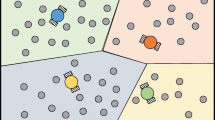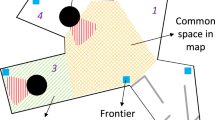Abstract
The Meeting problem for \(k\ge 2\) searchers in a polygon P (possibly with holes) consists in making the searchers move within P, according to a distributed algorithm, in such a way that at least two of them eventually come to see each other, regardless of their initial positions. The polygon is initially unknown to the searchers, and its edges obstruct both movement and vision. Depending on the shape of P, we minimize the number of searchers k for which the Meeting problem is solvable. Specifically, if P has a rotational symmetry of order \(\sigma \) (where \(\sigma =1\) corresponds to no rotational symmetry), we prove that \(k=\sigma +1\) searchers are sufficient, and the bound is tight. Furthermore, we give an improved algorithm that optimally solves the Meeting problem with \(k=2\) searchers in all polygons whose barycenter is not in a hole (which includes the polygons with no holes). Our algorithms can be implemented in a variety of standard models of mobile robots operating in Look–Compute–Move cycles. For instance, if the searchers have memory but are anonymous, asynchronous, and have no agreement on a coordinate system or a notion of clockwise direction, then our algorithms work even if the initial memory contents of the searchers are arbitrary and possibly misleading. Moreover, oblivious searchers can execute our algorithms as well, encoding information by carefully positioning themselves within the polygon. This code is computable with basic arithmetic operations (provided that the coordinates of the polygon’s vertices are algebraic real numbers in some global coordinate system), and each searcher can geometrically construct its own destination point at each cycle using only a compass and a straightedge. We stress that such memoryless searchers may be located anywhere in the polygon when the execution begins, and hence the information they initially encode is arbitrary. Our algorithms use a self-stabilizing map construction subroutine which is of independent interest.









Similar content being viewed by others
Notes
The typical assumption in this model is that a searcher’s local reference frame retains its orientation, scale, and handedness after each move. We will make this assumption as well, although it is not strictly needed by our algorithms (see the footnote in Sect. 2).
For this reason, there is no distributed algorithm that, for every polygon P, allows a team of memoryless searchers to either solve the Meeting problem in P or terminate if the problem is unsolvable in P.
A real number is said to be algebraic if it is a root of a polynomial with integer coefficients [8].
Collectively, these polygons constitute a subset of measure 0 of the set of all polygons with holes.
Here and throughout the paper, we will refer to the barycenter only because it is a well-defined point in every polygon. However, this choice is not essential: equivalently, we could take the center of symmetry if the polygon has one, or any point otherwise.
The fact that a searcher retains its local reference frame’s orientation, scale, and handedness is common in most of the related literature. However, in this work we will not strictly need it: in our algorithms, a searcher will always move (close) to a vertex of P. Hence, after a move, it will always be able to correctly match its new view with the previous one. This is possible even if its reference frame has reflected after the move: it is sufficient to make the searcher stop close enough to the angle bisector stemming from the destination vertex, but not exactly on it. On the next turn, the searcher will be able to tell its new reference frame’s handedness based on whether it is located to the left or the right of the angle bisector (cf. Sect. 4.2).
As an example, we show how to do it when P has no holes. Extending this method to the general case is just slightly more complicated, but the principles are the same. Pick the (unique) circle of smallest radius that contains all the vertices of P, and let r be its radius. Name the vertices of P \(v_0\), \(v_1\), ..., \(v_{n-1}\) in clockwise order. Pick any vertex \(v_i\), and construct the right-handed coordinate system having origin in \(v_i\), unit r, and x axis oriented like \(\overrightarrow{v_iv_{i+1}}\) (indices are always taken modulo n). Give a representation of P in this coordinate system, i.e., the ordered list of the x and y coordinates of \(v_{i+1}\), ..., \(v_n\), \(v_1\), ..., \(v_{i-1}\). Then construct another representation in the same coordinate system, but taking the vertices in the reverse order, i.e., \(v_{i-1}\), ..., \(v_1\), \(v_n\), ..., \(v_{i+1}\). Pick the lexicographically smaller of these two representations (if they are equal, pick any of them), and call it \(R_i\). Repeating the same construction with all the \(v_i\)’s yields the representations \(R_0\), \(R_1\), ..., \(R_{n-1}\): let \(R_m\) be the lexicographically smallest among them. Now, pick all vertices \(v_i\) such that \(R_i=R_m\): these constitute a rotation class of P chosen in a similarity-invariant way. Indeed, no matter how we rotate, translate, uniformly scale by a non-zero factor, or reflect P, we will always pick the same set of vertices.
References
Alpern, S., Gal, S.: The Theory of Search Games and Rendezvous. Springer, Berlin (2003)
Ando, H., Oasa, Y., Suzuki, I., Yamashita, M.: Distributed memoryless point convergence algorithm for mobile robots with limited visibility. IEEE Trans. Robot. Autom. 15(5), 818–828 (1999)
Blum, L., Cucker, F., Shub, M., Smale, S.: Complexity and Real Computation. Springer, New York (1998)
Bouchard, S., Bournat, M., Dieudonné, Y., Dubois, S., Petit, F.: Asynchronous approach in the plane: a deterministic polynomial algorithm. In: Proceedings of the 31st International Symposium on Distributed Computing (DISC), pp. 8:1–8:16 (2017)
Chalopin, J., Das, S., Disser, Y., Mihalák, M., Widmayer, P.: Mapping simple polygons: how robots benefit from looking back. Algorithmica 65(1), 43–59 (2013)
Chalopin, J., Das, S., Disser, Y., Mihalák, M., Widmayer, P.: Mapping simple polygons: the power of telling convex from reflex. ACM Trans. Algorithms 11(4), 33:1–33:16 (2015)
Cieliebak, M., Flocchini, P., Prencipe, G., Santoro, N.: Distributed computing by mobile robots: gathering. SIAM J. Comput. 41(4), 829–879 (2012)
Cohen, H.: A Course in Computational Algebraic Number Theory. Springer, Berlin (1993)
Czyzowicz, J., Ilcinkas, D., Labourel, A., Pelc, A.: Asynchronous deterministic rendezvous in bounded terrains. Theor. Comput. Sci. 412(50), 6926–6937 (2011)
Czyzowicz, J., Kosowski, A., Pelc, A.: Deterministic rendezvous of asynchronous bounded-memory agents in polygonal terrains. Theory Comput. Syst. 52(2), 179–199 (2013)
Czyzowicz, J., Labourel, A., Pelc, A.: How to meet asynchronously (almost) everywhere. ACM Trans. Algorithms 8(4), 37:1–37:14 (2012)
Défago, X., Gradinariu, M., Messika, S., Raïpin-Parvédy, P.: Fault-tolerant and self-stabilizing mobile robots gathering. In: Proceedings of the 20th International Symposium on Distributed Computing, (DISC), pp. 46–60 (2006)
Dieudonné, Y., Pelc, A.: Deterministic polynomial approach in the plane. Distrib. Comput. 28(2), 111–129 (2015)
Dieudonné, Y., Pelc, A., Villain, V.: How to meet asynchronously at polynomial cost. SIAM J. Comput. 44(3), 844–867 (2015)
Dieudonné, Y., Petit, F.: Self-stabilizing gathering with strong multiplicity detection. Theor. Comput. Sci. 428, 47–57 (2012)
Disser, Y., Mihalák, M., Widmayer, P.: Mapping polygons with agents that measure angles. In: Frazzoli, E., Lozano-Perez, T., Roy, N., Rus, D. (eds.) Algorithmic Foundations of Robotics X, pp. 415–425. Springer, Berlin (2013)
Di Luna, G.A., Flocchini, P., Gan Chaudhuri, S., Poloni, F., Santoro, N., Viglietta, G.: Mutual visibility by luminous robots without collisions. Inf. Comput. 254(3), 392–418 (2017)
Di Luna, G.A., Flocchini, P., Santoro, N., Viglietta, G., Yamashita, M.: Meeting in a polygon by anonymous oblivious robots. In: Proceedings of the 31st International Symposium on Distributed Computing (DISC), pp. 14:1–14:15 (2017)
Flocchini, P., Prencipe, G., Santoro, N.: Distributed Computing by Oblivious Mobile Robots. Morgan & Claypool, San Rafael (2012)
Flocchini, P., Prencipe, G., Santoro, N., Viglietta, G.: Distributed computing by mobile robots: uniform circle formation. Distrib. Comput. 30(6), 413–457 (2017)
Flocchini, P., Prencipe, G., Santoro, N., Widmayer, P.: Gathering of asynchronous robots with limited visibility. Theor. Comput. Sci. 337(1–3), 147–168 (2005)
Flocchini, P., Santoro, N., Viglietta, G., Yamashita, M.: Rendezvous with constant memory. Theor. Comput. Sci. 621, 57–72 (2016)
Hungerbühler, N.: A short elementary proof of the Mohr–Mascheroni theorem. Am. Math. Mon. 101(8), 784–787 (1994)
Kazarinoff, N.D.: Ruler and the Round: Classic Problems in Geometric Constructions. Dover, New York (2003)
Kiselev, A.P.: Kiselev’s Geometry Book I. Planimetry. Sumizdat, El Cerrito (2006)
Klobučar, D.: On nonexistence of an integer regular polygon. Math. Commun. 3(1), 75–80 (1998)
Lehmer, D.H.: A note on trigonometric algebraic numbers. Am. Math. Mon. 40(3), 165–166 (1933)
Pagli, L., Prencipe, G., Viglietta, G.: Getting close without touching: near-gathering for autonomous mobile robots. Distrib. Comput. 28(5), 333–349 (2015)
Rabinovich, W., Murphy, J., Suite, M., Ferraro, M., Mahon, R., Goetz, P., Hacker, K., Freeman, W., Saint Georges, E., Uecke, S., Sender, J.: Free-space optical data link to a small robot using modulating retroreflectors. In: Proceedings of SPIE 7464, Free-Space Laser Communications IX, 7464 (2009)
Rekleitis, I., Lee-Shue, V., Peng New, A., Choset, H.: Limited communication, multi-robot team based coverage. In: Proceedings of the IEEE International Conference on Robotics and Automation (ICRA), pp. 3462–3468 (2004)
Sharma, G., Busch, C., Mukhopadhyay, S.: Mutual visibility with an optimal number of colors. In: Proceedings of the 11th International Symposium on Algorithms and Experiments for Wireless Sensor Networks (ALGOSENSORS), pp. 196–210 (2016)
Sharma, G., Vaidyanathan, R., Trahan, J.L., Busch, C., Rai, S.: Complete visibility for robots with lights in O(1) time. In: Proceedings of the 18th International Symposium on Stabilization, Safety, and Security of Distributed Systems (SSS), pp. 327–345 (2016)
Shermer, T.: Hiding people in polygons. Computing 42(2), 109–131 (1989)
Suzuki, I., Yamashita, M.: Searching for a mobile intruder in a polygonal region. SIAM J. Comput. 21(5), 863–888 (1992)
Yamashita, M., Umemoto, H., Suzuki, I., Kameda, T.: Searching for mobile intruders in a polygonal region by a group of mobile searchers. Algorithmica 31(2), 208–236 (2001)
Acknowledgements
The authors wish to thank Francesco Veneziano for a clarifying discussion. This research has been supported in part by the Natural Sciences and Engineering Research Council of Canada under the Discovery Grant program and by Prof. Flocchini’s University Research Chair.
Author information
Authors and Affiliations
Corresponding author
Additional information
Publisher's Note
Springer Nature remains neutral with regard to jurisdictional claims in published maps and institutional affiliations.
A preliminary version of this paper has appeared at the 31st International Symposium on Distributed Computing (DISC’17) [18].
Rights and permissions
About this article
Cite this article
Di Luna, G.A., Flocchini, P., Santoro, N. et al. Meeting in a polygon by anonymous oblivious robots. Distrib. Comput. 33, 445–469 (2020). https://doi.org/10.1007/s00446-019-00362-2
Received:
Accepted:
Published:
Issue Date:
DOI: https://doi.org/10.1007/s00446-019-00362-2




